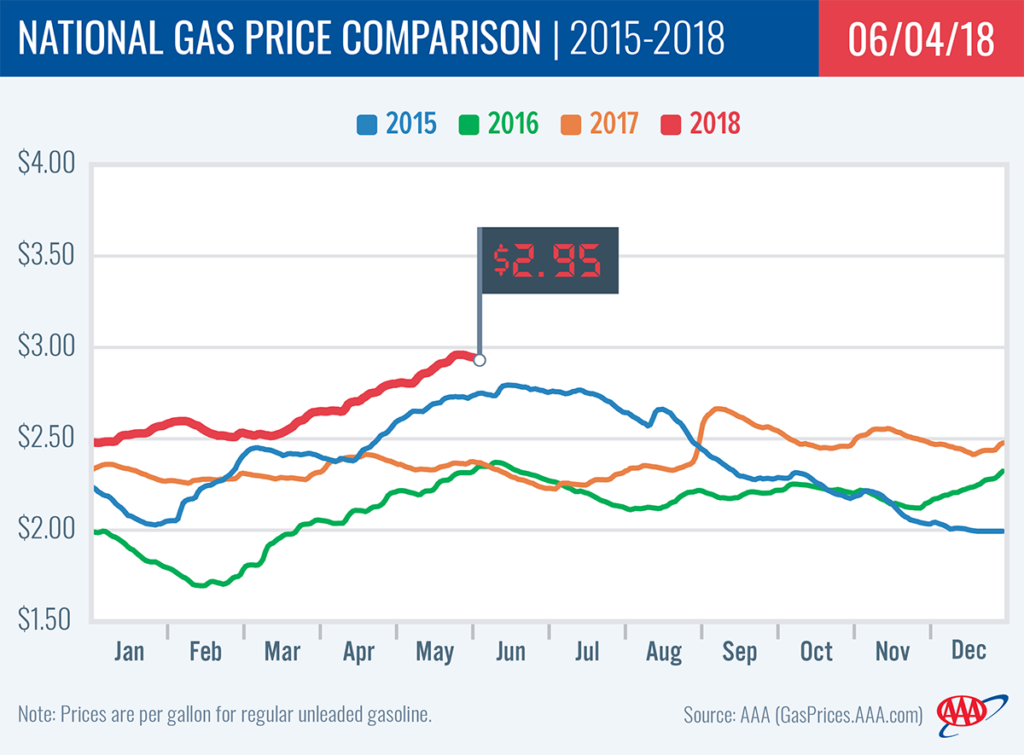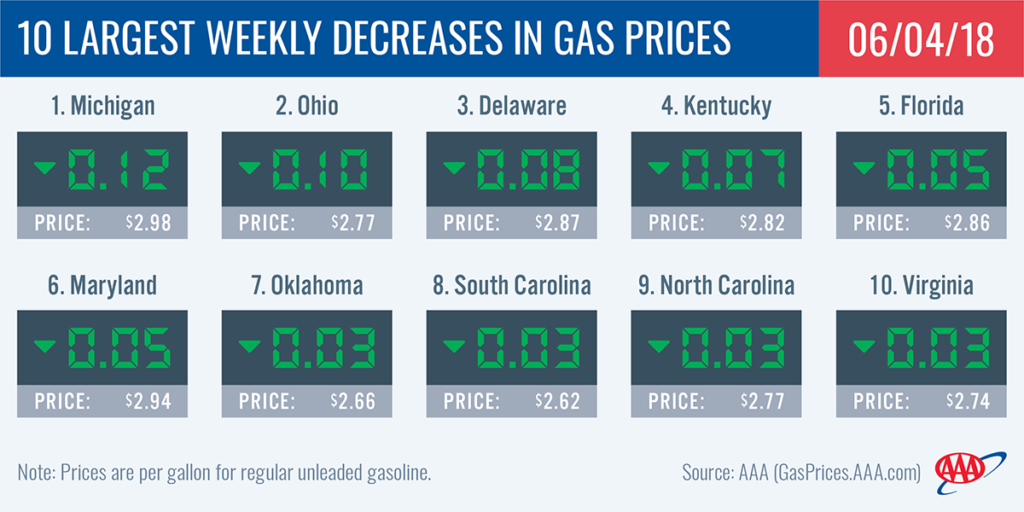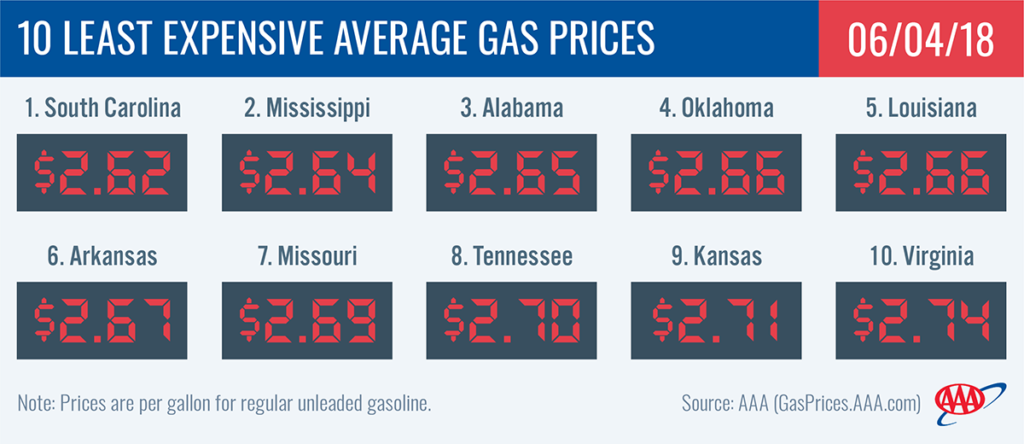Dropping by two-cents on the week, the national gas price average is $2.95. This is the first time there has been a decrease in the national average since mid-March. The drop, albeit it small, follows the latest Energy Information Administration (EIA) report showing consistently strong demand although it is running slightly below (100,000 b/d less) the same week last year.
“Nearly 80 percent of Americans say the price of gasoline is too high at $3 per gallon. So it’s welcome news for motorists to see gas price averages decrease in 33 states on the week,” said Jeanette Casselano, AAA gas price expert. “Crude oil prices are falling, but it likely won’t be enough to drop gas prices more significantly this summer.”
Today’s gas price average ($2.95) is 13-cents more than one month ago and 57-cents more than the beginning of June 2017. On the week, the majority of states saw decreases or hold steady, while those that saw prices jump were mostly West Coast and Rockies states.
Quick Stats
- The nation’s top 10 least expensive markets are: South Carolina ($2.62), Mississippi ($2.64), Alabama ($2.65), Oklahoma ($2.66), Louisiana ($2.66), Arkansas ($2.67), Missouri ($2.69), Tennessee ($2.70), Kansas ($2.71) and Virginia ($2.74)
- The nation’s top 10 largest weekly decreases are: Michigan (-12 cents), Ohio (-10 cents), Delaware (-8 cents), Kentucky (-7 cents), Florida (-5 cents), Maryland (-5 cents), Oklahoma (-3 cents), South Carolina (-3 cents), North Carolina (-3 cents) and Virginia (-3 cents).
West Coast
Drivers in the West Coast region are paying some of the highest gas prices in the country: California ($3.73), Hawaii ($3.71), Washington ($3.47), Alaska ($3.41), Oregon (3.35), Nevada ($3.33) and Arizona ($3.06). On the week, most gas prices in the region are flat, with Alaska and Arizona seeing the largest increases at two cents each.
According to EIA data for the week ending on May 25, inventories of gasoline climbed by an astonishing 1 million bbl to 31.3 million bbl. When compared to a year ago, levels are up more than 3 million bbl and could contribute to price stabilization in coming weeks.
Great Lakes and Central
On the week, Michigan’s gas price average ($2.98) dropped 12-cents, wiping out the previous week’s increases and lands prices below $3 for the first time in nearly two weeks. Michigan’s decrease was the biggest week-over-week change in the country. Fellow Great Lakes and Central states Ohio (-10 cents) and Kentucky (-7 cents) take the country’s second and fourth spots, respectively, with the largest decreases on the week. However, not every state is seeing less expensive prices. South Dakota’s and North Dakota’s state average (+2 cents) jumped since last Monday.
In the region, motorists will find the most expensive state gas prices averages in Illinois ($3.09), Indiana ($3.00) and Michigan ($2.98). The cheapest state averages can be found in Missouri ($2.69), Kansas ($2.71) and Ohio ($2.77).
Following EIA’s previous report of a regional 1.7 million bbl draw, gasoline inventories built in the latest report by 67,000 bbl on the week in the Great Lakes and Central states region. At the 52 million bbl mark, total inventories are on par with levels the past two years at this time. EIA data shows that levels fluctuate between 48-55 million bbl during the summer months.
South and Southeast
Florida (-5 cent), Oklahoma (-3 cent) and South Carolina (-3 cent) land on the top 10 list with the biggest weekly decreases. Gas price drops in the South and Southeast have been few and far between in the past two months. In the region, Texas was the only state to see gas prices increase. All other states saw prices moderately decrease or hold steady on the week.
The South and Southeast region is home to the top five cheapest gas price averages: South Carolina ($2.62), Mississippi ($2.64), Alabama ($2.65), Oklahoma ($2.66) and Louisiana ($2.66)
Gasoline inventories continue to sit at nearly 79 million bbl, which is on par with levels the past two years at this time. The region saw a small draw of 24,000 bbl on the week, according to EIA’s latest report.
Mid-Atlantic and Northeast
For the first time in months, pump prices decreased or held steady on the week for motorists in every state in the Mid-Atlantic and Northeast region. The most notable declines: Delaware (-8 cents), Maryland (-5 cents), North Carolina (-3 cents), Virginia (-3 cents) and Tennessee (-3 cent).
In the region, Connecticut ($3.15), Pennsylvania ($3.10), Washington, D.C. ($3.09), New York ($3.09), Rhode Island ($3.01) and New Jersey ($3.00) carry the most expensive gas prices. At $2.70, Tennessee motorist are paying the cheapest on average in the Mid-Atlantic and Northeast region.
Inventories dropped by nearly 525,000 bbl on the week in the Mid-Atlantic and Northeast region bringing totals to 64.7 million bbl. At the start of the summer driving season, inventories are at a 3.7 million deficit compared to last year.
Rockies
Most states in the Rockies region saw modest price jumps this week: Montana (+3 cents), Wyoming (+1 cents) and Idaho (+1 cent). Both Utah ($3.14) and Colorado ($2.90) saw prices drop by a penny.
Month over month, motorists in Colorado (+23 cents), Montana (+22 cents) and Wyoming (+19 cents) have seen sticker shock with gas prices increasing nearly a whole quarter compared to the beginning of last month (May 4). Planned seasonal refinery maintenance in the region has contributed to higher gas prices.
The region’s total inventories continue to measure at 6.9 million bbl, which is relatively unchanged on the week. EIA historical data shows that during the 2016 and 2017 summer season, inventories fluctuated between 6.3 and 7.5 million bbl.
Oil market dynamics
At the close of Friday’s formal trading session on the NYMEX, WTI dropped $1.23 to settle at $65.81. Crude prices fell at the end of the week because the dollar gained amid news of continued growth in the total number of jobs across the country. Earlier in the week, crude prices rose briefly after EIA’s weekly petroleum report showed that crude inventories fell by 3.6 million bbl.
Last week, EIA also released final crude production rates for March 2018, revealing that it hit a record-breaking 10.47 million b/d. The rate increased by 223,000 b/d from February 2018. Continued growth in crude production may reduce crude prices as it signals that supply is growing alongside strong global crude demand.
This continued crude production growth will put another spotlight on OPEC’s supply reduction agreement with its partners, which has been in place since the beginning of 2017. The agreement, which includes production from Russia, is set to expire at the end of 2018. However, member countries of OPEC and Russia have been discussing potentially easing supply limits ahead of the agreement’s dissolution at the end of the year. If the cartel and its partners decide to increase crude output, they will likely announce the decision on June 22 at the next OPEC meeting in Vienna, Austria.
Additionally, Baker Hughes, Inc. reported that the U.S. added two oil rigs last week, bringing the total to 861. The total is up by 128 rigs when compared to last year at this time.
Motorists can find current gas prices along their route with the free AAA Mobile app for iPhone, iPad and Android. The app can also be used to map a route, find discounts, book a hotel and access AAA roadside assistance. Learn more at AAA.com/mobile.



